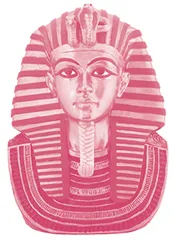A Brief History of Archaeology考古简史
作者: 杨树锋译

The word “archaeology” comes from the Greek word “arkhaios,” which means “ancient.” Although some archaeologists study living cultures, most archaeologists concern themselves with the distant past.
archaeology(考古学)一词源自希腊语arkhaios,义为“古代”。尽管有些考古学家研究现存的文化,但大多数考古学家关注的是遥远的过去。
People have dug up monuments1 and collected artifacts for thousands of years. Often, these people were not scholars, but looters and grave robbers looking to make money or build up their personal collections.
人们数千年来一直在挖掘遗迹、收集文物。这些人通常并非学者,而是意图发财或建立个人收藏的劫掠者和盗墓人。
For instance, grave robbers have been plundering the magnificent tombs of Egypt since the time the Pyramids were built. Grave robbing was such a common crime in ancient Egypt that many tombs have hidden chambers where the family of the deceased would place treasures.
例如,自金字塔建成以来,盗墓人就一直在掠夺这些宏伟的埃及陵墓。在古埃及,盗墓犯罪司空见惯,以致很多坟墓都有暗室,死者家属将财宝放置其中。
In Egypt in the mid-1800s, an Egyptian man searching for a lost goat stumbled across the tomb of Pharaoh Ramses I. (Many archaeologists doubt this story and say grave robbers, working as an organized group, routinely scouted and plundered many tombs in the area.) Ramses I ruled for a short time in the 1290s BCE. Besides the body of the pharaoh, the tomb held artifacts such as pottery, paintings, and sculpture. The man sold the mummies and artifacts from the tomb to anyone who would pay.
19世纪中叶,在埃及,有一名埃及男子找寻丢失的山羊,偶然闯进了法老拉美西斯一世的陵墓。(许多考古学家对这一说法存疑,他们说,盗墓贼一般是有组织的团伙作案,经常搜寻和劫掠当地的许多坟墓。)公元前 1290年代,拉美西斯一世短暂统治过埃及。除了法老的遗体,墓中还藏有陶器、绘画和雕塑等文物。该男子将墓中的木乃伊和文物卖给了愿意出钱的人。
The mummy of Ramses I wound up in a museum in Niagara Falls, Ontario, Canada, where it remained until the museum closed in 1999. The Canadian museum sold the Egyptian collection to the Michael C. Carlos Museum in Atlanta, Georgia, which confirmed the mummy’s royal status through the use of CT scanners, X-rays, radiocarbon dating, computer imaging, and other techniques. Ramses I was returned to Egypt in 2003.
几经辗转,拉美西斯一世木乃伊后来落脚于加拿大安大略省尼亚加拉瀑布城的一座博物馆,直到1999年博物馆关闭。这家加拿大博物馆将埃及藏品出售给了美国佐治亚州亚特兰大的迈克尔·C. 卡洛斯博物馆,后者借助CT扫描仪、X射线、放射性碳年份测定、计算机成像和其他技术,证实了木乃伊的王室身份。2003年,拉美西斯一世木乃伊被归还给埃及。
One of the most well-known archaeological finds is the tomb of Pharaoh Tutankhamun, also known as King Tut. Unlike many other Egyptian tombs, grave robbers had never discovered King Tut. His resting place lay undisturbed for thousands of years, until it was discovered in 1922. In addition to mummies of Tutankhamun and his family, the tomb contained some 5,000 artifacts.
最著名的考古发现之一是图坦卡蒙法老(亦名图特王)的陵墓。与其他许多埃及陵墓不同,从未有盗墓人发现过图特王。在1922年被发现前,他的安息之地数千年来一直无人打扰。除了图坦卡蒙及其家人的木乃伊外,该墓还包含约5000件文物。
Many early archaeologists worked in the service of invading armies. When Gen. Napoleon Bonaparte of France successfully invaded Egypt in 1798, he brought artists, archaeologists, and historians to document the conquest. Napoleon’s troops took home hundreds of tons of Egyptian artifacts: columns, coffins, stone tablets, monumental statues. Today, these Egyptian antiquities take up entire floors of the Louvre Museum in Paris, France.
许多早期的考古学家为侵略军效力。法国的拿破仑于1798年成功入侵埃及时,还带来了艺术家、考古学家和历史学家以记录这次征服。拿破仑军队将数百吨埃及文物运回了法国,包括柱子、棺材、石碑和碑像。如今,这些埃及文物摆满了法国巴黎卢浮宫博物馆整整几层展区。
Some archaeologists of this time were wealthy adventurers, explorers, and merchants. These amateur archaeologists often had a sincere interest in the culture and artifacts they studied. However, their work is often regarded as an example of colonialism and exploitation. The so-called Elgin Marbles are an example of this controversy.
这一时期的考古学家中不乏富有的冒险家、探险家和商人。此类业余考古学家对他们所研究的文化和文物常怀有真诚的兴趣。然而,他们的所作所为往往也被视为殖民主义和剥削的例证。所谓的“埃尔金大理石雕”就是这种争议的例证之一。
In 1801, Greece had been taken over by the Ottoman Empire. The British ambassador to the Ottoman Empire, Lord Elgin, received permission to remove half of the sculptures from the famous Acropolis of Athens, Greece. These marble sculptures were a part of buildings such as the Parthenon. Lord Elgin claimed he wanted to protect the valuable sculptures from damage caused by conflict between the Greeks and the Ottomans2.
1801年,彼时希腊已被奥斯曼帝国占领。英国驻奥斯曼帝国大使埃尔金勋爵获准从希腊著名的雅典卫城移走一半的雕塑。这些大理石雕塑是帕特农神庙等建筑的一部分。埃尔金勋爵声称他是想保护这些珍贵的雕塑,以免损毁于希腊人和奥斯曼土耳其人之间的冲突。
The government of Greece has been lobbying for the return of the Elgin Marbles ever since. Most Greeks view the sculptures as part of their cultural heritage. Greece has cut off diplomatic relations to the United Kingdom several times, demanding the return of the sculptures, which remain in the British Museum in London.
此后希腊政府一直在游说,要求英国返还“埃尔金大理石雕”。大多数希腊人都将这些雕塑视为希腊文化遗产的一部分。希腊曾数次断绝与英国的外交关系,要求归还这些现今仍留在伦敦大英博物馆里的雕塑。
Eventually, archaeology evolved into a more systematic discipline. Scientists started using standard weights and measures and other formalized methods for recording and removing artifacts. They required detailed drawings and drafts of the entire dig site, as well as individual pieces. Archaeologists began to work with classicists, historians, and linguists to develop a unified picture of the past.
最终,考古学演变成一门更系统的学科。科学家启用标准度量衡及其他固定方法来对文物进行记录和转移。他们需要整个发掘现场——以及单个物件——的详细图纸和草图。考古学家开始与古典学者、历史学家和语言学家合作,为过往构建一幅统一的图景。
In the 20th century, archaeologists began to re-assess their impact on the cultures and environments where they dig. Today, in most countries, archaeological remains become the property of the country where they are found, regardless of who finds them. Egypt, for example, is scattered with archaeological sites sponsored by American universities. These teams must obtain permission from the Egyptian government to dig at the sites, and all artifacts become the property of Egypt.
20世纪,考古学家开始重新评估自己对发掘所在地文化和环境的影响。今天,在大多数国家,无论发现者是谁,考古文物都属于发现地所在国的财产。例如,埃及境内散布着由美国大学赞助发掘的考古场地。这些考古队必须获得埃及政府的批准方可在现场挖掘,而且所有文物都是埃及的财产。